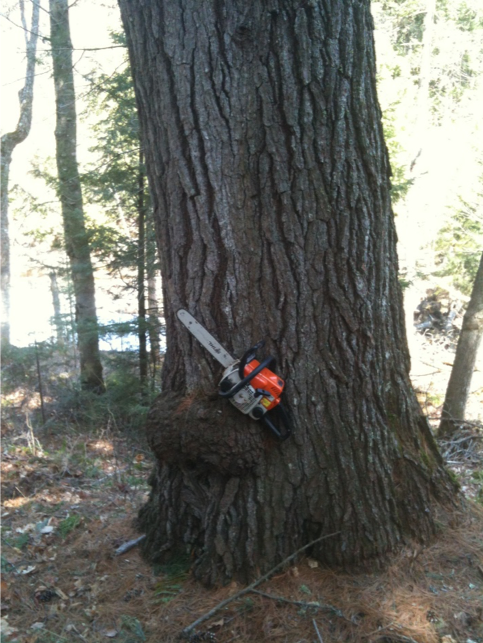Écrire une chronique sur le lac Gagnon, c’est aussi faire un retour sur le passé et essayer de se rappeler ses débuts au lac, pour ceux qui y étaient à partir de 1950, dont moi. Mais c’est aussi se remémorer ou vouloir raconter ce qu’on sait du lac Gagnon, dont son nom d’avant 1968, soit le lac Long. Cette chronique ne se veut pas un cours d’histoire, mais un retour dans le temps s’impose quand même un peu. Ce sera aussi une suite de petits récits qui donneront une idée de ce qu’était le lac et de ce qu’il est maintenant. Sans prétentions. L’idée de cette chronique est celle de Louis St Hilaire, actuel président de l’Association des propriétaires du lac Gagnon (APLG). C’est un “ vieux ” du lac comme moi, ou presque. Mes plus vieux souvenirs datent de 1950 environ. Avant, ce sont les versions de mon grand-père Albert. Ses souvenirs à lui ce sont ceux de son père Georges, qui a baptisé certains de ses enfants à Duhamel en 1902-03.
 Commençons donc par ses premiers habitants, des Algonquins. Je ne reculai pas jusqu’en 1653, où ceux-ci furent décimés par les Iroquois au lac Nominingue selon les récits de l’époque. L’histoire pour nous et pour certains habitants de Duhamel et ses descendants débute approximativement à la colonisation de la région, soit fin du 19e siècle. Une des premières cartes sur laquelle on voit le lac Long a été produite par Joseph Bureau explorateur et arpenteur. Tout un personnage. Elle a été préparée selon les instructions de la compagnie forestière Gilmour & Co. en 1852 et dont voici le lien: Plan North Nation 1852 pour ceux qui voudraient la voir à l’écran. La version papier se trouve en page annexe. Évidemment, c’est le bois qui intéresse les forestiers, en particulier le pin blanc, alors en abondance et de très bonne qualité. Sur cette carte on y voit aussi les portages indiens. Ce document permet de supposer que les paysages que l’on voit actuellement diffèrent sensiblement de ceux de cette époque. Le grand pin blanc, dont un spécimen typique de l’époque peut être encore croisé sur le sentier Caroline dans la forêt ancestrale, a plus de 12 pi (4m) à la base! Aujourd’hui, le pin blanc se fait plus rare. On n’a qu’à regarder le sommet des montagnes vue du lac. Ceux qui dépassent beaucoup plus que les autres sont les derniers témoins de cette époque.
Commençons donc par ses premiers habitants, des Algonquins. Je ne reculai pas jusqu’en 1653, où ceux-ci furent décimés par les Iroquois au lac Nominingue selon les récits de l’époque. L’histoire pour nous et pour certains habitants de Duhamel et ses descendants débute approximativement à la colonisation de la région, soit fin du 19e siècle. Une des premières cartes sur laquelle on voit le lac Long a été produite par Joseph Bureau explorateur et arpenteur. Tout un personnage. Elle a été préparée selon les instructions de la compagnie forestière Gilmour & Co. en 1852 et dont voici le lien: Plan North Nation 1852 pour ceux qui voudraient la voir à l’écran. La version papier se trouve en page annexe. Évidemment, c’est le bois qui intéresse les forestiers, en particulier le pin blanc, alors en abondance et de très bonne qualité. Sur cette carte on y voit aussi les portages indiens. Ce document permet de supposer que les paysages que l’on voit actuellement diffèrent sensiblement de ceux de cette époque. Le grand pin blanc, dont un spécimen typique de l’époque peut être encore croisé sur le sentier Caroline dans la forêt ancestrale, a plus de 12 pi (4m) à la base! Aujourd’hui, le pin blanc se fait plus rare. On n’a qu’à regarder le sommet des montagnes vue du lac. Ceux qui dépassent beaucoup plus que les autres sont les derniers témoins de cette époque.
Qui habitait au lac Long à cette époque? Selon un recensement de 1861 (Recensement 1861) par les Sulpiciens au lac Long (nom indien Kajakokanak, qui signifie long) et au Grand lac Preston, alors appelé Grand lac du Poisson Blanc (Atikamekong en Algonguin), il n’y avait que des Algonquins sauf un canadien marié à une autochtone habitant sur ce dernier. On y retrouve aussi certains noms ou prénoms qui ont encore un usage aujourd’hui au lac Gagnon. Pointe-à-Baptiste, Dam-à-Tanascon, Creek Simon (rivière Ernest), Roche-à-Jean (au sud ouest du lac avant d’arriver à la grande plage. Ces appellations font référence à Simon Kanawato, Jean-Baptiste Bernard, Louis nascon. Nous verrons dans une prochaine chronique l’arrivée des premiers colons et leur impact sur le lac Long
